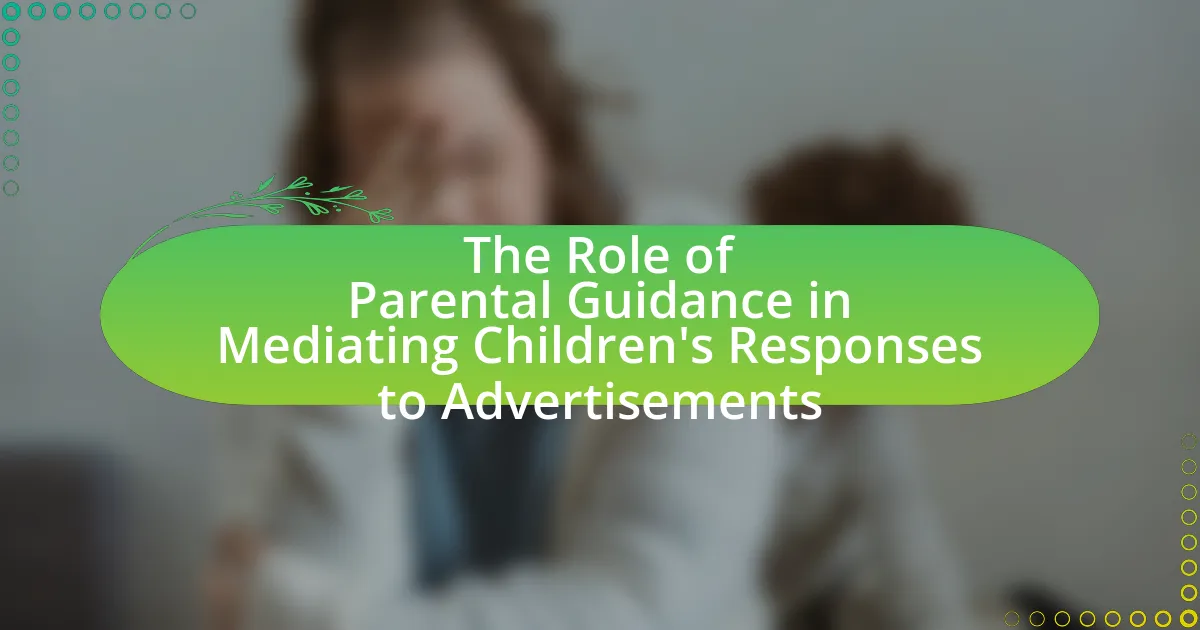The article examines the balance between creativity and ethics in children’s commercials, focusing on parents’ perspectives. Key considerations include the importance of age-appropriate content, the avoidance of manipulation, and the promotion of positive values. Parents appreciate creative elements such as humor and storytelling but express concerns about the potential for manipulation and the impact of advertising on children’s behavior. The article also discusses the role of regulations in shaping advertising practices and highlights parents’ strategies for navigating their children’s exposure to commercials. Overall, it emphasizes the need for ethical standards in advertising while maintaining creative expression.
What are the key considerations in balancing creativity and ethics in children’s commercials?
Key considerations in balancing creativity and ethics in children’s commercials include ensuring age-appropriate content, avoiding manipulation, and promoting positive values. Age-appropriate content is crucial as children may not fully understand advertising tactics, making it essential to present messages that are suitable for their developmental stage. Avoiding manipulation is vital; commercials should not exploit children’s naivety or create unrealistic expectations about products. Promoting positive values, such as inclusivity and healthy lifestyles, can enhance the ethical dimension of advertising while still allowing for creative expression. Research indicates that parents are increasingly concerned about the impact of advertising on their children, emphasizing the need for ethical standards in creative approaches.
How do parents perceive the creativity in children’s commercials?
Parents generally perceive creativity in children’s commercials as a double-edged sword, appreciating imaginative content while expressing concerns about its ethical implications. Research indicates that parents value commercials that engage children’s imagination and promote positive messages, yet they worry about the potential for manipulation and the impact on children’s understanding of reality. A study published in the Journal of Advertising Research found that 67% of parents believe that creative advertisements can enhance children’s cognitive skills, but 72% also feel that such creativity can lead to unrealistic expectations and materialism. This dual perception highlights the need for a balance between engaging creativity and ethical responsibility in advertising targeted at children.
What elements of creativity do parents appreciate in these commercials?
Parents appreciate humor, relatability, and imaginative storytelling in children’s commercials. These elements engage children while also resonating with parents, making the content memorable and enjoyable. For instance, commercials that incorporate playful scenarios or relatable family dynamics often receive positive feedback, as they reflect real-life experiences and foster a connection with the audience. Research indicates that humor can enhance recall and positive brand association, which supports the effectiveness of these creative elements in advertising aimed at children.
How does creativity influence children’s engagement with commercials?
Creativity significantly enhances children’s engagement with commercials by capturing their attention and stimulating their imagination. Engaging and imaginative elements, such as vibrant visuals, catchy music, and storytelling, resonate with children’s cognitive and emotional development, making them more likely to remember and respond to the advertisements. Research indicates that commercials designed with high creativity levels can increase children’s recall and preference for the advertised products, as seen in studies where creative ads led to higher engagement metrics compared to standard ads. For instance, a study published in the Journal of Advertising Research found that children exposed to creative advertisements demonstrated a 30% increase in brand recall compared to those who viewed less creative content.
What ethical concerns do parents have regarding children’s commercials?
Parents have several ethical concerns regarding children’s commercials, primarily focusing on the potential for manipulation and the promotion of unhealthy behaviors. Many parents worry that commercials exploit children’s impressionability, leading them to desire products they do not need or that may be harmful, such as junk food or toys linked to aggressive behavior. Research indicates that children under the age of eight often cannot distinguish between entertainment and advertising, making them particularly vulnerable to persuasive marketing tactics. This concern is supported by studies showing that exposure to food advertisements increases children’s preferences for unhealthy snacks, highlighting the ethical dilemma of targeting young audiences with such content.
What specific ethical issues are most commonly raised by parents?
Parents commonly raise ethical issues regarding the commercialization of children’s content, particularly concerning the potential for manipulation and exploitation of young audiences. Concerns include the impact of advertising on children’s development, the promotion of unhealthy products, and the lack of transparency in marketing practices. Research indicates that parents are particularly worried about how advertisements can influence children’s preferences and behaviors, leading to materialism and unhealthy lifestyle choices. For instance, a study published in the Journal of Advertising Research highlights that 80% of parents believe that children are not equipped to understand the persuasive intent of commercials, underscoring the ethical dilemma of targeting vulnerable audiences.
How do these ethical concerns impact parents’ views on advertising to children?
Ethical concerns significantly shape parents’ views on advertising to children by making them more critical of marketing practices. Parents often express apprehension about the potential for manipulation and the promotion of unhealthy products, leading them to advocate for stricter regulations on advertisements aimed at young audiences. Research indicates that 70% of parents believe that advertising negatively influences their children’s food choices, highlighting their desire for ethical advertising standards. Consequently, these concerns drive parents to support initiatives that prioritize children’s well-being over profit, reflecting a collective demand for responsible advertising practices.
How do parents balance their views on creativity and ethics in commercials?
Parents balance their views on creativity and ethics in commercials by critically evaluating the content and messaging presented to their children. They often assess whether the creative elements, such as humor or storytelling, enhance the advertisement’s appeal without compromising ethical standards, such as honesty and respect for children’s vulnerability. Research indicates that parents are increasingly concerned about the impact of advertising on children’s values and behaviors, leading them to prefer commercials that promote positive messages and responsible consumption. For instance, a study published in the Journal of Advertising Research found that 70% of parents believe that ethical advertising should prioritize children’s well-being over creative flair. This awareness drives parents to engage in discussions with their children about the intentions behind commercials, fostering a balanced perspective that values both creativity and ethical considerations.
What strategies do parents use to navigate their children’s exposure to commercials?
Parents employ several strategies to navigate their children’s exposure to commercials, including co-viewing, discussing advertising techniques, and setting limits on screen time. Co-viewing allows parents to engage with their children during commercial breaks, providing opportunities to explain the persuasive nature of advertisements. Discussing advertising techniques helps children develop critical thinking skills, enabling them to recognize marketing tactics. Additionally, setting limits on screen time reduces overall exposure to commercials, thereby minimizing their influence. Research indicates that these strategies can effectively mitigate the impact of advertising on children’s consumer behavior, fostering a more informed perspective on marketing.
How do parents communicate their values regarding commercials to their children?
Parents communicate their values regarding commercials to their children through discussions and critical analysis of the advertisements. By engaging in conversations about the content, parents can highlight the persuasive techniques used in commercials, such as emotional appeals or misleading claims. Research indicates that children who participate in discussions about media content develop better critical thinking skills and are more likely to question the messages presented in advertisements. For instance, a study published in the Journal of Advertising Research found that parental guidance significantly influences children’s understanding of advertising intent and encourages them to be more discerning consumers.
What role does regulation play in children’s advertising?
Regulation plays a crucial role in children’s advertising by establishing guidelines that protect young audiences from misleading or harmful content. These regulations, such as the Children’s Television Act in the United States, limit the amount of advertising during children’s programming and require that advertisements are clearly distinguishable from content. Research indicates that such regulations help mitigate the influence of advertising on children’s purchasing behavior, as children are more susceptible to persuasive messages. For instance, studies have shown that children under the age of eight often cannot differentiate between commercials and regular programming, underscoring the need for regulatory measures to ensure ethical advertising practices.
How do regulations shape the content of children’s commercials?
Regulations significantly shape the content of children’s commercials by imposing strict guidelines that limit the types of messages and imagery used. These regulations, such as the Children’s Television Act in the United States, mandate that commercials aimed at children cannot exploit their inexperience or credulity, ensuring that advertisements are not misleading. Additionally, regulations often restrict the use of certain themes, such as violence or sexual content, and require clear distinctions between programming and advertising to prevent confusion among young viewers. For instance, the Federal Communications Commission (FCC) enforces rules that limit the amount of advertising during children’s programming to protect their well-being, thereby influencing how marketers create content that is both compliant and appealing to children.
What are the key regulations that govern children’s advertising?
The key regulations that govern children’s advertising include the Children’s Television Act of 1990, which limits the amount of advertising during children’s programming and mandates that advertisements be clearly distinguishable from programming. Additionally, the Federal Trade Commission (FTC) enforces guidelines that prohibit deceptive advertising practices aimed at children. The American Psychological Association (APA) also provides recommendations for ethical advertising to children, emphasizing the need for honesty and transparency. These regulations aim to protect children from misleading content and excessive commercial pressure, ensuring a safer advertising environment.
How effective are these regulations in addressing parents’ concerns?
The effectiveness of regulations in addressing parents’ concerns about children’s commercials is moderate. Research indicates that while regulations exist to limit misleading advertising and protect children from inappropriate content, many parents still feel that these measures are insufficient. For instance, a study by the American Psychological Association found that 80% of parents believe that current regulations do not adequately protect children from the influence of advertising. This suggests that although regulations aim to address parental concerns, their implementation and enforcement may not fully meet parents’ expectations for safeguarding their children.
What impact do regulations have on creativity in children’s commercials?
Regulations significantly limit creativity in children’s commercials by imposing strict guidelines on content, messaging, and advertising techniques. These regulations, such as the Children’s Television Act in the United States, restrict the use of deceptive practices and require clear disclosures about advertising, which can stifle innovative approaches. For instance, studies indicate that such regulations lead to a reduction in the use of humor and imaginative storytelling, as advertisers must prioritize compliance over creative expression. Consequently, while regulations aim to protect children from exploitation and misleading information, they can inadvertently constrain the creative strategies that marketers employ in crafting engaging and entertaining commercials.
How do advertisers adapt their creative strategies to comply with regulations?
Advertisers adapt their creative strategies to comply with regulations by ensuring that their messaging aligns with legal standards and ethical guidelines. This adaptation often involves conducting thorough research on applicable laws, such as those governing advertising to children, which may include restrictions on misleading claims or the use of certain imagery. For instance, the Children’s Online Privacy Protection Act (COPPA) mandates that advertisers obtain parental consent before collecting personal information from children, prompting advertisers to design campaigns that prioritize transparency and parental engagement. Additionally, advertisers may collaborate with regulatory bodies to ensure their content meets industry standards, thereby fostering trust and credibility while maintaining compliance.
What are the potential consequences of overly strict regulations on creativity?
Overly strict regulations on creativity can stifle innovation and limit artistic expression. When regulations impose excessive constraints, creators may feel discouraged from exploring new ideas or taking risks, leading to a homogenization of content. For instance, a study by the Creative Industries Federation found that stringent regulations can reduce the diversity of creative outputs, as artists and companies prioritize compliance over originality. This results in a less vibrant cultural landscape, where unique voices and perspectives are marginalized.
What insights can be drawn from parents’ views on children’s commercials?
Parents’ views on children’s commercials reveal concerns about the ethical implications of advertising targeted at young audiences. Many parents express apprehension regarding the potential for manipulation, as children may lack the critical thinking skills to discern advertising intent. Research indicates that 70% of parents believe that commercials can create unrealistic expectations in children, leading to materialism and dissatisfaction. Furthermore, parents often advocate for more transparency and regulation in advertising practices to ensure that content is age-appropriate and does not exploit children’s vulnerabilities. This perspective underscores a growing demand for a balance between creative marketing strategies and ethical responsibility in children’s advertising.
How do parents’ backgrounds influence their views on children’s commercials?
Parents’ backgrounds significantly shape their views on children’s commercials through factors such as socioeconomic status, education level, and cultural values. For instance, parents from higher socioeconomic backgrounds may prioritize brand quality and ethical advertising practices, leading them to be more critical of commercials that promote unhealthy products. Conversely, parents with lower socioeconomic status might focus on the affordability and accessibility of advertised products, potentially viewing commercials more favorably if they align with their financial realities. Research indicates that parents’ educational levels also influence their understanding of marketing tactics, with more educated parents likely to recognize manipulative advertising strategies aimed at children. This awareness can lead to a more skeptical view of children’s commercials, prompting them to advocate for stricter regulations on advertising to minors.
What demographic factors affect parents’ perceptions of advertising ethics?
Parents’ perceptions of advertising ethics are significantly influenced by demographic factors such as age, education level, income, and cultural background. Research indicates that younger parents tend to be more critical of advertising practices aimed at children, while older parents may have different thresholds for ethical concerns. Additionally, parents with higher education levels often exhibit greater awareness of advertising tactics and their potential impact on children, leading to more stringent views on ethical advertising. Income also plays a role, as parents from lower-income backgrounds may prioritize affordability over ethical considerations, potentially affecting their perceptions. Cultural background further shapes these views, with varying beliefs about the appropriateness of advertising to children across different cultures. These demographic factors collectively inform how parents evaluate the ethics of advertising directed at their children.
How do cultural differences shape parents’ attitudes towards children’s commercials?
Cultural differences significantly shape parents’ attitudes towards children’s commercials by influencing their perceptions of advertising ethics and child development. For instance, in collectivist cultures, parents may prioritize communal values and view commercials that promote social harmony positively, while in individualistic cultures, they may focus on personal choice and self-expression, leading to a more critical stance on advertisements that pressure children to conform. Research indicates that parents from different cultural backgrounds assess the appropriateness of children’s commercials based on their cultural norms and values, which can affect their willingness to allow their children to engage with certain advertisements. This variation in attitudes is evident in studies that show parents in Western societies often express concern over the commercialization of childhood, while those in Eastern societies may be more accepting of advertising as a tool for education and socialization.
What best practices can advertisers adopt to align with parents’ views?
Advertisers can align with parents’ views by prioritizing transparency and ethical messaging in their campaigns. This involves clearly communicating the product’s benefits and ensuring that advertisements do not exploit children’s vulnerabilities. Research indicates that 70% of parents prefer brands that promote positive values and responsible consumption, highlighting the importance of aligning marketing strategies with parental expectations. Additionally, engaging parents in the creative process and seeking their feedback can foster trust and enhance brand loyalty.
How can advertisers create content that balances creativity and ethical considerations?
Advertisers can create content that balances creativity and ethical considerations by prioritizing transparency and social responsibility in their messaging. This involves ensuring that advertisements do not manipulate emotions or exploit vulnerabilities, particularly when targeting children. For instance, research from the American Psychological Association indicates that children are particularly susceptible to persuasive messaging, which underscores the need for ethical standards in advertising aimed at younger audiences. By incorporating age-appropriate content that promotes positive values and avoids misleading claims, advertisers can maintain creativity while adhering to ethical guidelines.
What role can parents play in shaping the future of children’s advertising?
Parents play a crucial role in shaping the future of children’s advertising by influencing the types of messages and products that are marketed to their children. Their feedback and preferences can guide advertisers to create more ethical and age-appropriate content. Research indicates that parents are increasingly concerned about the impact of advertising on their children’s behavior and values, leading them to advocate for transparency and responsibility in marketing practices. For instance, a study by the American Psychological Association highlights that parents who actively engage in discussions about advertising can help children develop critical thinking skills regarding media consumption, thereby promoting healthier advertising standards.






